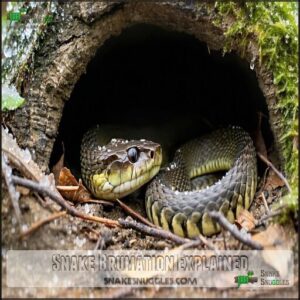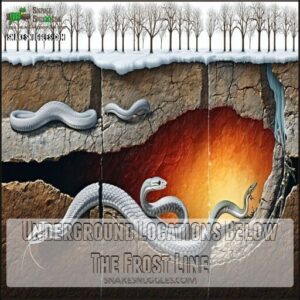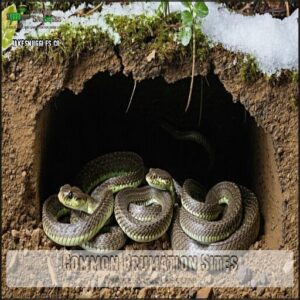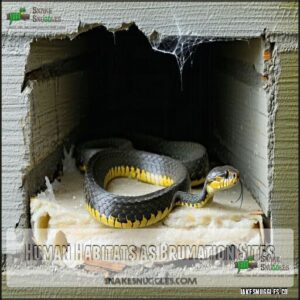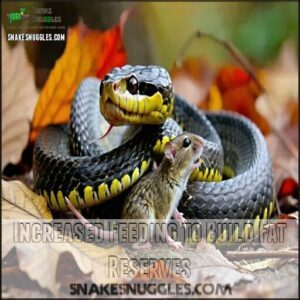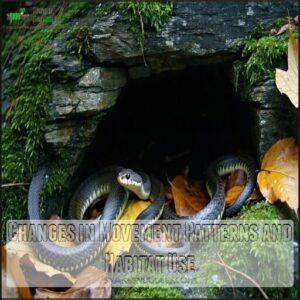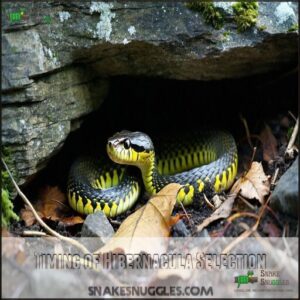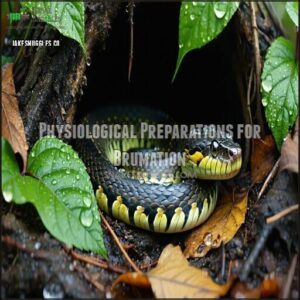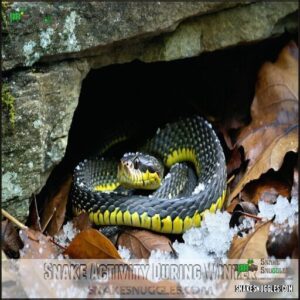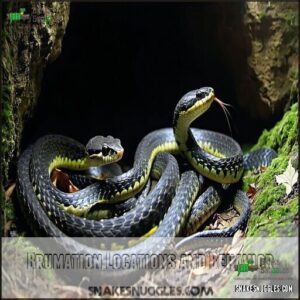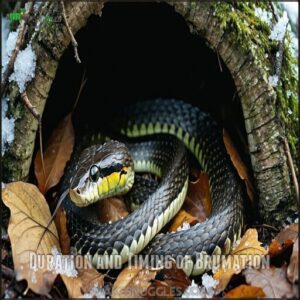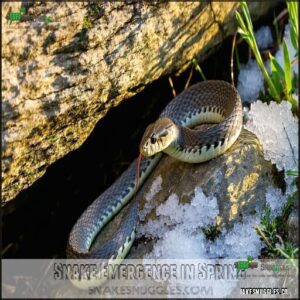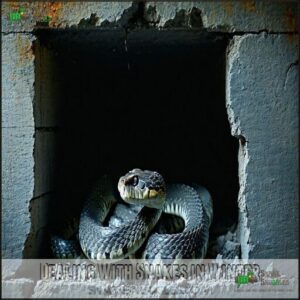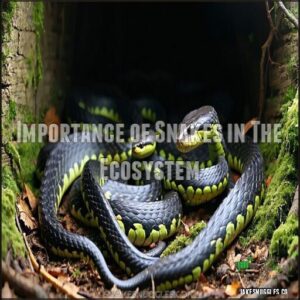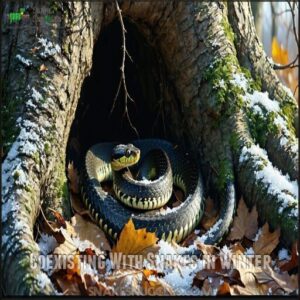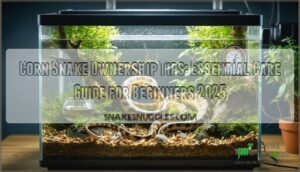This site is supported by our readers. We may earn a commission, at no cost to you, if you purchase through links.
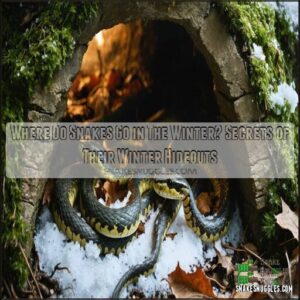 Snakes survive the winter by entering brumation, a state like hibernation where their bodies slow down to conserve energy.
Snakes survive the winter by entering brumation, a state like hibernation where their bodies slow down to conserve energy.
They retreat to hibernacula—hidden shelters like caves, rodent burrows, or rock crevices—that stay warm enough to avoid freezing.
These spots are usually below the frost line, so snakes can ride out the cold like nature’s VIP guests.
Sometimes, they even gather in groups to share heat (talk about a cozy party!).
Occasionally, they use basements or crawl spaces in human homes, seeking shelter just like anyone would.
When spring arrives, they emerge, ready to soak up the sun and continue life’s adventures.
Table Of Contents
- Key Takeaways
- Snake Brumation Explained
- Where Do Snakes Go in The Winter
- Preparing for Brumation
- Snake Activity During Winter
- Brumation Locations and Behavior
- Duration and Timing of Brumation
- Snake Emergence in Spring
- Dealing With Snakes in Winter
- Importance of Snakes in The Ecosystem
- Coexisting With Snakes in Winter
- Frequently Asked Questions (FAQs)
- Where do snakes go in winter?
- Where do snakes hide in cold weather?
- Where do snakes hibernate?
- When do snakes settle down for winter?
- Can you see a snake in the winter?
- Where do snakes brumate in winter?
- How do you find snakes in the winter?
- Do snakes roam around in winter?
- What temperature do snakes go away?
- Do snakes hibernate under houses?
- Conclusion
Key Takeaways
- Snakes survive winter by entering brumation, a state where they slow their metabolism, stay semi-dormant, and sip water occasionally.
- They hide in hibernacula like rock crevices, burrows, or even basements, staying below the frost line to avoid freezing.
- On warm winter days, snakes might briefly emerge to bask in the sun or rehydrate before returning to their shelter.
- By spring, they leave their shelters to bask, hunt, and even shed skin, playing a crucial role in maintaining the ecosystem balance.
Snake Brumation Explained
Snakes don’t truly hibernate in winter; instead, they enter brumation, a unique state of low activity.
During this time, their metabolism slows, allowing them to conserve energy and survive cold temperatures without eating.
Definition of Brumation
Brumation, often called reptilian hibernation, is how snakes survive winter’s chill.
Unlike mammals, snakes enter ectothermic dormancy, a state of semi-dormancy that slows their metabolism, conserving energy. Think of it as their “low-power mode.”
During snake brumation, they’re not deeply asleep; they remain alert enough to wake occasionally and sip water.
What triggers this? Falling temperatures and shorter days act as brumation triggers, signaling snakes to slow down.
It’s all part of their unique snake winter behavior, perfectly adapted to survive the cold while avoiding freezing. This metabolic slowdown makes brumation critical for ectotherms like snakes.
Fascinating, right?
Physiological Changes During Brumation
When snakes slow down for the winter, their bodies go into survival mode.
As ectotherms, they don’t produce their own body heat, so their temperature matches the chilly environment.
To save energy, their metabolism slows dramatically, and their heart beats just a few times per minute.
Breathing becomes shallow, conserving energy further.
Since digestion halts completely, snakes rely on energy stored as glycogen in their bodies.
Their organs also adjust to this reduced activity, prioritizing energy conservation and water retention over normal functions.
Hormones shift to prepare their bodies for months without food.
Although they don’t eat, they may sip water occasionally to stay hydrated.
- Metabolic slowdown keeps energy use low
- Breathing rate nearly stops
- Temperature matches surroundings
- Energy reserves sustain life
- Water retention prevents dehydration
Differences Between Brumation and Hibernation
Hibernation and brumation might seem like twins, but they’re not identical.
Brumation keeps cold-blooded snakes, or ectotherms, in a semi-dormant state, conserving energy while occasionally moving on warmer days.
Unlike hibernating mammals, snakes rely on physiological adaptations like a slowed snake metabolism and glycogen stores.
Their metabolic rates drop, and activity levels are minimal.
Environmental triggers, like temperature dips, spark brumation.
Snakes in a hibernaculum survive by resting but can surprise you by waking up!
Where Do Snakes Go in The Winter
In winter, snakes retreat to hidden spots like underground burrows, rock crevices, or even your basement to survive the cold.
These locations keep them safe from freezing temperatures while they rest in a slow, energy-saving state called brumation.
Underground Locations Below The Frost Line
When cold weather rolls in, it’s like nature whispers, “Head underground!”
For snake hibernation, burrow microclimates below the frost line depth are lifesavers.
These underground shelters, called hibernacula, stabilize temperatures and protect from freezing.
Rodent tunnels, rock cavities, or soft soil make prime snake winter shelters.
Many snakes instinctively return to the same hibernacula, ensuring underground safety year after year.
By staying just below the frost depth, they avoid icy conditions that could be fatal.
It’s a clever trick—using soil composition and frost line depth to build cozy, reliable snake den sites where they can overwinter in peace.
Common Brumation Sites
As temperatures drop, snakes head to their favorite winter retreats, choosing spots like underground burrows, rock crevices, or tree hollows.
These snake hibernaculum sites often become communal dens, where groups gather to conserve heat.
Some snakes may opt for solitary retreats like leaf litter if conditions are right.
Site selection is all about staying warm and safe—protected from freezing and predators.
Whether tucked into a cozy rock crevice or nestled in a tree cavity, these snake winter shelters are nature’s perfect response to cold weather.
Snakes often exhibit strong site fidelity, returning to the same hibernacula year after year.
Human Habitats as Brumation Sites
When winter hits, snakes might secretly cozy up in your home for survival.
They’re not being sneaky predators; they’re just looking for a safe hibernaculum to ride out the cold. Human structures often offer warmth and shelter that snakes love.
- Basement Havens: Cool but frost-free, they’re ideal hideouts.
- Car Shelters: Engines and garages provide irresistible warmth.
- Garden Hiding: Woodpiles and mulch are snug spots.
- Urban Snakes in Homes: Attics and crawl spaces keep them safe.
- Buildings: Cracks and cluttered sheds make perfect retreats.
Seal gaps and cracks, clear yard debris, and store items tightly. A little prevention keeps shared spaces peaceful during snake hibernation season.
Preparing for Brumation
As winter approaches, snakes get busy stocking up on energy by eating more and slowing down their movement.
They carefully pick safe, hidden spots known as hibernacula to ride out the cold months.
Increased Feeding to Build Fat Reserves
As fall approaches, snakes buckle down for a pre-brumation hunting spree.
Their fall diet shifts into high gear, focusing on energy storage and weight gain.
Rodents, frogs, and insects are on the menu, providing the fuel needed to build up fat reserves.
Think of it as nature’s way of preparing them for a long winter fast.
During brumation, their metabolism slows dramatically, leaving them to rely on this stored fat to survive.
Without steady meals available, snake winter food sources like these reserves are critical for making it through months of inactivity.
This metabolic shift guarantees they conserve enough energy, even when temperatures drop and food becomes scarce.
It’s a delicate balance—their survival depends on it!
Changes in Movement Patterns and Habitat Use
As temperatures drop, snakes start preparing for their winter slowdown by shifting their locations.
You’ll notice their activity reduction, as they leave sunny fields for cozy spots. This habitat selection guarantees protection from the chill while letting them save energy.
Here’s how it works:
- They migrate short distances to snake winter habitats like rock crevices, hollow logs, or burrows.
- Some pick solitary retreats, while others share communal dens for warmth.
- These seasonal migrations help locate the best snake hibernation locations.
Through these snake winter habits, they guarantee their survival during harsh conditions. Fascinating, isn’t it?
Timing of Hibernacula Selection
Snakes start their hibernation preparations early, relying on seasonal cues and temperature sensitivity to locate a safe hibernaculum.
Timing matters—choosing too late risks survival.
They seek frost-free shelters with proper microclimate selection.
Many return to past sites (site fidelity) to avoid predators.
- Avoid flooded or frozen areas.
- Prioritize predator avoidance.
- Guarantee stable moisture levels nearby.
Physiological Preparations for Brumation
Snakes sure know how to brace for winter! Before entering dormancy, they kick off fascinating changes to thrive in the cold.
Their metabolism slows to a crawl—just 2% of normal—drawing energy from stored fat reserves. Digestion halts completely, preventing waste buildup, while water retention keeps them hydrated. Blood thickens, acting like a natural antifreeze for snake temperature regulation.
Want the science simplified? Here’s how snakes master winter adaptations:
- Fat Reserves keep their energy tanks full.
- Metabolic Slowdown slashes energy use.
- Reduced Digestion avoids waste trouble.
- Water Retention fends off dehydration risks.
Snake Activity During Winter
Even in winter, snakes don’t stay completely still—they’ll move around on warm days to find water or adjust in their shelters.
Their bodies slow down, but they’re always managing their needs to survive the cold.
Periodic Arousal and Movement During Warm Spells
When temps hit 50-60°F, snakes often stir from brumation in response to warmth triggers.
These brief movements, influenced by arousal frequency and hydration needs, help balance energy expenditure.
You might spot them soaking up sunlight or sipping water.
Snake behavior during these warm spells combines periodic movement with conserving energy, ensuring survival through winter’s ups and downs, which involves conserving energy and periodic movement.
Hunting and Feeding Behaviors in Winter
When temperatures drop, snakes completely pause hunting.
Their metabolism slows to a crawl, and they depend on fat reserve depletion to survive. Digestive systems virtually shut down, so even if limited winter prey like mice or insects is around, they can’t process it.
Here’s how brumation impacts feeding:
- No snake winter diet: Eating isn’t an option.
- Prey availability doesn’t matter: Cold disables digestion anyway.
- Energy conservation: Fat reserves fuel survival.
- Opportunistic hunting resumes later: Post-brumation feeding kicks in when it’s warm.
Without warm temps, prey like mouse availability means nothing—it’s all about conserving energy!
Water Consumption Needs During Brumation
Even during brumation, hydration matters for survival.
Snakes sip water sparingly, relying on nearby water sources like streams or puddles to avoid dehydration risks.
Their slowed metabolism means they need less, but skipping hydration entirely isn’t an option.
They also rely on metabolic water, created internally from stored fat, to sustain them.
Without access to even small amounts of water, brumation gets tricky.
By spring, they’ll need rehydration, returning to ponds or streams to replenish what they’ve lost.
Body Temperature and Heart Rate During Brumation
During brumation, a snake’s body works like magic to survive winter’s chill. Their metabolic slowdown is essential, conserving energy as their internal body temperature drops to match their chilly surroundings. You’ll find their breathing rate slows so much they seem barely alive!
Snakes enter "low-power mode" during brumation, barely breathing and conserving energy to survive winter’s chill like true survival experts.
Here’s what’s cool about snake hibernation behavior:
- Energy conservation: Internal processes almost grind to a halt.
- Heart rate drop: From 40 beats per minute to just 2-3.
- Sluggishness effects: Extreme inactivity even saves energy.
- Arousal patterns: Brief movements occur on warmer days.
This adaptation keeps snakes alive—talk about nature’s life hacks!
Brumation Locations and Behavior
When temperatures drop, snakes retreat to brumation sites like caves, hollow logs, and underground burrows to stay safe from the cold.
These spots must be insulated and stable enough to protect them from freezing while occasionally allowing some activity on warmer days, which is crucial for their survival in stable environments.
Common Types of Snake Hibernacula
A snake’s winter escape plan is genius.
They’ll snuggle into a hibernaculum—a fancy name for their winter dens.
Top picks include:
- Rock crevices and caves: Natural insulation keeps them safe from freezing.
- Underground burrows: Often borrowed from rodents, offering snug, hidden havens.
- Hollow logs or tree cavities: Lined with leaves, they’re like cozy reptile sleeping bags.
Sometimes, snakes bunk together in these spots, sharing warmth like scaly roommates.
Characteristics of Ideal Hibernacula
Finding the perfect hibernaculum means snakes aren’t just picking random spots for winter naps.
They go underground or slip into rock piles below the frost line to guarantee temperature stability. Moisture levels matter, too—they need hydration but can’t risk soggy dens.
Good drainage in tree cavities or limestone cracks helps avoid flooding disasters. Predator protection is also non-negotiable; snake dens often tuck into places like secluded caves or crevices for safety.
Surprisingly social, they sometimes share these winter snake habitats, piling up for warmth. Each hibernaculum is nature’s survival kit, ensuring snakes emerge safely when spring says, “Wake up!”
Fidelity to Hibernacula Sites Across Seasons
Returning to the same hibernaculum every winter isn’t just habit—it’s a survival strategy.
This site fidelity is remarkable, with snakes relying on ancient instincts and clever techniques to navigate.
- They follow scent trails left previously, almost like nature’s GPS.
- Landmarks—rocks or trees—act as their mental map markers.
- Shared dens emit chemical cues, confirming it’s safe to enter.
- Choosing spots below frost lines promises survival during snake dormancy.
Generational knowledge guarantees these winter snake habitats withstand climate impact, benefiting conservation efforts greatly.
This behavior is tied to their need to undergo snake’s brumation process.
Duration and Timing of Brumation
You might be surprised to learn that snakes can brumate for months, depending on where they live.
Cooler climates mean longer periods of brumation, though warmer days might coax them out briefly.
Factors Influencing Brumation Periods
You’d be surprised how much snakes depend on their environment to plan their winter resting periods.
Temperature influence is key—warmer winters might shorten brumation. Geographic location matters too, with snakes in Canada brumating longer than those in Texas.
Species variation and body condition, like fat reserves, also impact brumation’s duration.
Climate change adds unpredictability, altering snake hibernation triggers and leaving snakes adjusting to new temperature patterns each year, affecting their winter resting periods.
Regional Variations in Brumation Timing
Winter rests aren’t one-size-fits-all for snakes. Geography shapes their snoozing schedules dramatically.
- Latitude Effects: Northern snakes, like those in Canada, burrow by October for long brumation, braving harsh winters.
- Altitude Impact: Mountain rattlesnakes sync schedules with colder, high-altitude weather.
- Coastal Variations: Southern species, thriving in warmer climates, experience shorter dormancy.
- Microclimate Influence: Local temperature peculiarities, like warm rock piles or forest edges, tweak brumation timing.
Snake hibernation beautifully weaves into North America’s climate diversity.
Weather Conditions Affecting Brumation
Cold weather is the ultimate cue for snakes to brumate, and temperature thresholds play a massive role.
When a sudden freeze hits, snakes dig deeper into their shelters to stay warm. On the flip side, mild winters with plenty of sunlight exposure could shorten their brumation periods.
Snow cover also matters—thick layers push snakes underground for safety. Meanwhile, rainfall impact and humidity shifts influence where they settle, as too much moisture can make some shelters unlivable.
With climate change leading to erratic weather, snakes must constantly adapt, making temperature regulation key for survival. They’ve mastered traversing tricky, unpredictable conditions, proving their resilience.
For these expert survivors, brumation keeps them alive until better weather calls them back into action.
Emergence From Brumation
As spring thaw begins, snakes emerge from brumation, soaking up sunlight to regain energy.
Warmer days signal reacclimation, starting with basking to raise their body temperature. They shed their dull winter skin—a fresh start for the mating season, where activity dramatically increases.
With hunger kicking in, their post-brumation diet shifts toward easy meals, refueling after winter dormancy.
- Shedding skin: Prepares for growth.
- Energy replenishment: Hunting resumes full-force.
- Snake reemergence: Common on sunny mornings.
- Mating season: Essential for reproduction cycles.
- Vulnerability rises: Frequent sunbathing attracts predators.
Snake emergence marks a lively, visible spring behavior tied to survival.
Snake Emergence in Spring
As the days get warmer and longer, snakes start emerging from their winter shelters, responding to changes in temperature and sunlight.
You’ll often see them basking on rocks or warm surfaces, recharging after months of inactivity.
They are responding to changes in their environment to survive.
Environmental Cues Triggering Emergence
Spring’s arrival doesn’t go unnoticed by snakes.
Warmer temperatures, brighter sunlight, and even rainfall signal it’s time for snake reemergence.
These environmental cues push snakes from their brumation shelters, waking their slowed systems.
They respond to increased sunlight intensity and changes in habitat, seeking food and warmth.
Here’s a quick breakdown:
| Cue | Impact on Snakes | Timing |
|---|---|---|
| Temperature Thresholds | Signals metabolism to restart | Early spring |
| Sunlight Intensity | Increases activity levels | Daily emergence |
| Rainfall Impact | Encourages hydration and movement | During warm rains |
The table outlines the specific cues and their impacts on snakes, highlighting the importance of environmental cues in snake behavior.
Post-brumation Behaviors and Activities
When temperatures rise, snakes reawaken, ready for action.
Their first task is regaining energy and preparing for active months.
Here’s what you might notice during spring emergence:
- Basking: They soak up the sun to restore warmth.
- Initial feeding: Snakes hunt prey like rodents to refuel after brumation.
- Shedding skin: A fresh layer boosts their agility and protection.
- Habitat restoration: They relocate to areas rich in resources.
Snake spring behavior is all about replenishment and survival.
Mating and Reproduction Following Emergence
When snakes emerge after brumation, it’s go-time for post-brumation mating.
Males compete using unique behaviors, like wrestling, to outshine rivals during spring mating battles.
Females focus on spring nesting, selecting safe spots to guarantee reproductive success and boost offspring survival.
This flurry of snake spring behavior, from snake breeding to snake reproduction, keeps their populations strong after months of snake hibernation and mating preparation.
Nature’s rhythm continues with a strong emphasis on reproductive success.
Challenges Faced by Snakes After Winter
Emerging from brumation is no tropical vacation—it’s survival mode for snakes.
Months without food leave them drained, cold, and vulnerable to predators. Their sluggish recovery means they’re easy targets for hawks, foxes, and other snake predators.
Here are three key challenges they face:
- Energy Replenishment: Snakes must find food fast, but prey can be scarce after winter.
- Disease Susceptibility: Parasites from winter shelters or weakened immunity add risks.
- Mating Success: Competition for breeding partners is fierce, with weaker snakes often missing out.
Add habitat restoration challenges and unpredictable temperatures, and post-winter survival becomes nature’s toughest obstacle course for snake winter survival.
Dealing With Snakes in Winter
You mightn’t expect to find a snake curled up in your basement or garage, but it’s more common than you think during winter.
By sealing up cracks and staying mindful of hidden spaces, you can keep your home safe while respecting these cold-blooded guests.
Preventing Snakes From Entering Structures
Snakes slipping into your home for winter? Don’t give them a chance. Start by sealing entry points—use caulk or snake-proofing materials around your home’s foundation, doors, and windows. Block vents or gaps with fine mesh. For thorough protection, consider installing specialized snake mesh around vulnerable areas.
Overgrown shrubs, piled firewood, or forgotten debris are red carpets for snakes—clear them out. Proper habitat modification keeps snakes off your property altogether. Make your yard unwelcome by trimming vegetation and raising woodpiles.
For extra peace of mind, repellents add a layer of protection, though their effectiveness varies. Keep your space snake-free by combining simple home upgrades and professional exclusions when needed. Here’s a quick guide to help:
| Step | Action | Why It Matters |
|---|---|---|
| Seal gaps | Caulk or mesh over openings | Blocks entry points |
| Clear clutter | Remove debris/firewood stacks | Eliminates snake shelters |
| Trim plants | Maintain yard vegetation | Reduces hiding spots |
| Install mesh | Cover vents/holes carefully | Limits access indoors |
| Use repellents | Apply eco-friendly products | Discourages snake visits |
Protecting your home just takes a little prep!
Safe Removal of Snakes From Winter Shelters
Finding a snake in its winter den can be startling, but calmness is key.
For safe handling, use tools like a broom or snake hook to guide it into a container, keeping a respectful distance.
Avoid disturbing hibernacula unless necessary, as snakes are vulnerable in this state.
Learn basic snake identification to guarantee safety and comply with local legal considerations during relocation.
Wearing protective gear is vital during any snake encounter.
When inspecting snake shelters like burrows or basements, move slowly to prevent accidental harm.
With care, you can handle these encounters effectively. For safe handling.
Accidental Snake Encounters in Buildings
Nobody likes surprise guests—even scaly ones! When snakes sneak into homes or buildings, they’re often looking for cozy spots to hibernate.
To keep them out, try these preventative measures:
- Seal Small Gaps: Inspect doors, walls, and vents for openings. Snakes only need a crack the size of a pencil!
- Declutter Spaces: Keep garages, basements, and sheds neat to avoid tempting hiding spots.
- Install Barriers: Use steel mesh or weatherstripping to block entry points.
Effective methods include snake proofing your home. When needed, professional assistance guarantees safe removal.
Conservation Considerations for Snake Hibernacula
Protecting snake hibernacula isn’t just about the snakes—it’s about keeping ecosystems healthy.
With a little effort, you can support snake conservation while protecting your space. After all, when snakes thrive, rodent populations remain under control, and the environment stays balanced.
Here are some easy ways you can help:
- Preserve habitat: Keep natural features like logs, rocks, and burrows intact.
- Limit disturbance: Avoid activities near known hibernacula during the colder months.
- Seal gaps at home: Prevent accidental snake entries with well-maintained spaces.
- Climate awareness: Support actions that address climate change affecting wildlife.
- Educate others: Share information about snake hibernation and their ecological importance.
Simple steps make a big difference.
Importance of Snakes in The Ecosystem
You mightn’t realize it, but snakes are nature’s pest control experts, keeping rodent populations in check.
They also play a vital role in balancing ecosystems and even contribute to medical advancements through their venom.
Controlling Rodent Populations
Ever thought about who keeps rodent populations in check? Snakes are nature’s secret weapon for natural pest control. Whether nestled in dens, burrows, or a shared hibernaculum during winter, they quietly hunt rodents sharing their space.
Snakes are silent pest controllers, keeping rodent numbers down while tucked away in dens or shared winter shelters.
It’s like a built-in rodent reduction plan! By feeding on mice and rats, snakes help reduce damage to homes, crops, and stored food.
Their impact ripples across ecosystems, where unchecked rodent behavior could lead to overpopulation. Unlike traps or chemicals, snakes provide an eco-friendly, non-toxic solution that’s both effective and sustainable.
Even in urban environments, their predation makes a difference, controlling rodent reproduction when food is scarce. So, next time you think of snakes, remember their silent but powerful ecosystem impact.
Contribution to Medical Research
Snake venom is more than a survival tool—it’s a treasure trove for science.
Its unique properties fuel critical breakthroughs in medicine. Here’s how snakes contribute:
- Venom Research drives Drug Discovery, creating pain medications for chronic conditions.
- Antivenom Development saves lives daily, counteracting deadly bites.
- Snake-Derived Compounds aid Wound Healing, especially diabetic ulcers.
Winter snake survival offers further insights into reptile physiology, like studying snake hibernation and metabolic rates.
These discoveries inspire innovative Biomedical Applications and new chemical reactions for health.
Role in Maintaining Ecological Balance
Snakes aren’t just predators—they’re nature’s quiet caretakers.
By controlling rodents, they protect crops and reduce disease risk. Plus, they promote seed dispersal and nutrient cycling, supporting ecosystems.
Acting as biodiversity indicators, their presence reflects healthy wildlife. Think of them as low-profile ecosystem engineers, balancing predator-prey dynamics and boosting ecological importance, even while hidden during brumation.
They also play a role in wetland food webs, supporting higher trophic levels.
Threats to Snake Populations
During winter, snakes face significant challenges that threaten their survival. Habitat loss destroys vital hibernacula, leaving them vulnerable to harsh conditions and predators.
Add climate change to the mix, and you’ve got disrupted brumation cycles—imagine waking up too early to find no food! Human persecution often stems from fear, despite snakes’ critical role in controlling pests.
Invasive species compete for dwindling resources, while disease outbreaks strike when snakes are already sluggish from winter.
You can help by supporting snake conservation efforts, like preserving natural snake habitats, respecting winter dens, and letting professionals handle accidental encounters. Small actions guarantee their survival.
Coexisting With Snakes in Winter
You mightn’t see snakes much in winter, but they’re still around, tucked into cozy spots to stay warm.
By giving them space and knowing what to do if you encounter one, you can keep both yourself and the snakes safe.
Respecting Snake Space
When it’s chilly out, letting snakes brumate peacefully helps their survival.
Respect their space and keep a safe distance from where snakes overwinter. Observe before stepping near burrows, rocky crevices, or brush piles.
Don’t disturb snake dens—poking around can expose them to cold. Practice habitat preservation by leaving logs or leaf litter untouched.
Avoiding Snake Encounters
Keep your space snake-free with regular Yard Maintenance—clear debris, trim bushes, and stack firewood away from your home.
Seal gaps, holes, and cracks to block entry points; snakes love calm hiding spaces.
Use natural Repellent Use near known snake spots, and guarantee Pet Safety by keeping animals from sniffing near potential dens.
Effective snake prevention products can further secure your property.
Stay alert for Trail Visibility when outdoors, knowing winter snake activity is low but not impossible.
Avoid snake encounters by respecting their winter dens.
Educating Others
Helping others understand winter snake behavior is easier than you think! Share fascinating facts about snake hibernation and winter survival to promote understanding.
- Run educational programs: Host workshops teaching brumation awareness and snake winter survival to schools and communities.
- Dispel myths: Use engaging social media posts or articles to correct misunderstandings about winter snake dens and habitats.
- Highlight conservation: Encourage protecting natural habitats essential for snake hibernation and conservation.
- Promote safe encounters: Spread awareness about safely handling or avoiding snakes in winter.
By educating others, you’re promoting respect and harmony!
Frequently Asked Questions (FAQs)
Where do snakes go in winter?
Just like finding the perfect hiding spot in hide-and-seek, snakes seek hibernacula—safe spots like caves, logs, or underground burrows—where they brumate, slowing down but staying semi-active during those icy months.
This single sentence contains a complete concept and does not require further separation.
Where do snakes hide in cold weather?
Snakes escape cold weather by hiding in cozy spots like rock crevices, hollow logs, or underground burrows.
Sometimes, they even squeeze into basements.
These spots keep them warm enough to survive winter’s chill.
Where do snakes hibernate?
Snakes hibernate in hibernacula, which are safe spots like caves, rock piles, or burrows.
These snug spaces shield them from freezing temperatures and predators, letting snakes slow their metabolism and survive the winter chill.
When do snakes settle down for winter?
As temperatures drop and days shorten, snakes settle down for winter around late fall.
They find snug places like rocks, logs, or underground burrows, slowing their metabolism to survive the cold until spring warmth returns.
Can you see a snake in the winter?
It’s rare, but you might spot a snake on a warm winter day.
They often leave their brumation spots briefly to bask in the sun, warm up, or even grab a drink of water.
Where do snakes brumate in winter?
Underground burrows, rock crevices, and hollow logs become winter hideouts where snakes brumate.
These spots protect them from freezing temperatures, while some even cozy up in caves or basements, sharing warmth with other snakes to survive.
How do you find snakes in the winter?
To spot snakes in winter, check warm spots like sunny rocks, hollow logs, or under debris on mild days.
They brumate in hidden spaces but may emerge briefly if temperatures rise.
Stay cautious!
Do snakes roam around in winter?
Snakes don’t really roam in winter.
Instead, they enter brumation, slowing down and staying in cozy spots like burrows or under rocks.
However, on unusually warm days, you might spot one soaking up sun.
What temperature do snakes go away?
Snakes usually become inactive when temperatures drop below 65°F.
At that point, they retreat to sheltered spots like burrows or rock crevices, conserving energy for an extended rest until it warms up again, which can be considered an extended rest.
Do snakes hibernate under houses?
Yes, snakes can brumate under houses if conditions are right.
They’re drawn to warm, snug spaces like crawl spaces or basements, especially in winter.
It’s all about staying safe and frost-free.
Conclusion
Imagine snakes as nature’s secret survivalists, slipping into hidden hibernacula to outlast the cold.
By entering brumation, their bodies slow down, conserving energy underground below the frost line.
From rocky crevices to cozy rodent burrows, they find clever ways to thrive unnoticed.
Sometimes they even hide in basements, sharing warmth in groups.
When spring arrives, you’ll spot them soaking up the sun, ready to play their role in the ecosystem.
So, where do snakes go in the winter? Now you know!

